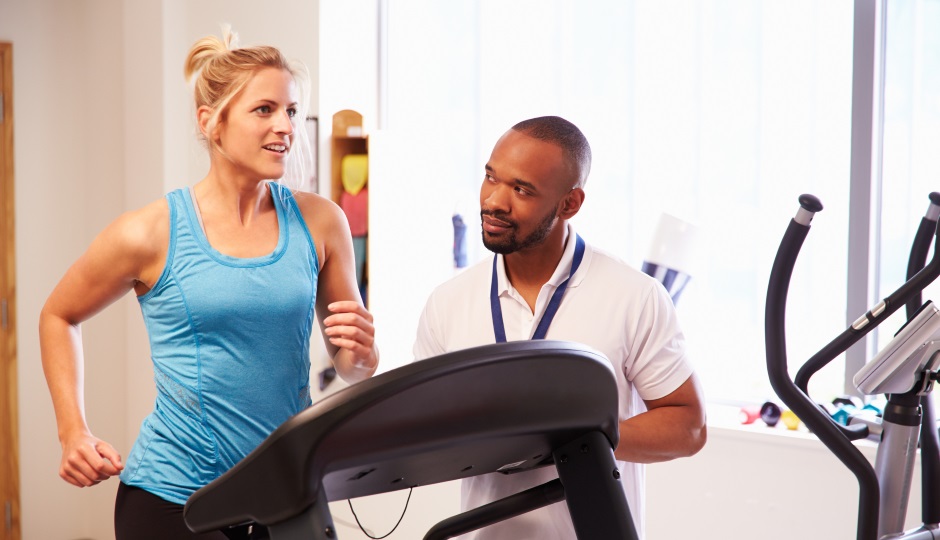Is Exercise A Key Treatment For People With Multiple Sclerosis? These Penn Medicine Specialists Say Yes

Photo credit: Getty Image/monkeybusinessimages
For people who suffer from multiple sclerosis (MS), some days the pain can make it your instinct to curl into a ball and stay in bed. But, according to the certified MS specialists at Penn Medicine, that is actually the opposite of what you should do. Their work finds exercise is actually one of the most important parts of treatment for people with MS.
If you think exercising with MS sounds crazy, you’re not alone. Many MS patients avoid exercise, thinking it will aggravate pain or worsen their fatigue. Research shows the opposite is true—exercise can actually improve symptoms, according to Diana Duda, PT, DPT, MSCS. Diana is a physical therapist at Penn Therapy and Fitness at Rittenhouse and a Multiple Sclerosis Certified-specialist who treats patients will all types of MS along the continuum of the disease process.
Diana answers some commonly asked questions below and explains why exercise is so important for a patient with MS.
Q: Exercise is always important for good health. What makes it especially important for patients with MS?
Regular, moderate physical exercise is good for the body, mind, and mood — and this is very true for patients with MS. When you have MS and you exercise, it can improve your fitness, endurance, and strength in your arms and legs.
Studies have shown that this can also give you better control over your bowel and bladder function, and decreased overall fatigue. And it can give your mood a boost.
Q: What are the best exercises?
The best MS exercises are aerobic exercises, stretching, and progressive strength training.
Aerobic exercise is any activity that increases your heart rate, like walking, jogging, or swimming. You just don’t want to overdo it—it should be done at a moderate level. I tell patients to get to a level where you can talk but not sing—you’ll be breathing heavily and may be sweating. It is recommended you get in at least 150 minutes of total moderate-intensity aerobic activity per week.
Stretching is recommended for at least 10 minutes per day. It’s the best way to maintain your range of motion, and ease symptoms that are related to spasticity (muscle tightness or stiffness, or a lack of muscle control). Yoga or Tai Chi are great ways to get your stretching in.
Strength or resistance training helps you maintain and improve your muscle strength. You can use machines, weights, bands—just make sure to hit all the muscle groups. This should be done at least twice a week.
Also, take some time to warm up first. It doesn’t matter if you’re doing aerobic exercise, stretching, or strength training—before any workout, you should warm up. Try easy cycling or walking.
Q: What precautions should a patient take before exercising?
It’s extremely important to stay hydrated and cool. Getting too hot when you’re exercising can temporarily increase your MS symptoms, like fatigue or spasticity. Start slowly and drink plenty of water. Exercise in a room with good ventilation or a fan, and wear cool, breathable fabrics. You also want to take time to recover, and monitor yourself to make sure that you’re not overdoing your workouts. I like to use the two-hour rule. If you don’t feel as well two hours after exercising as you did before you started, then you probably did too much.
Q: Do you have any tips for helping someone who doesn’t like to exercise get started?
I remind them that exercise doesn’t have to be boring or a chore. Take a class at a community center or gym so you get to be social. Try exercise videos at home if you don’t want to go to a gym.
If you feel like you’re short on time, you can get exercise from your daily activities—shopping, gardening, housework, walking the dog—anything you can do to stay active.
Q: How do you keep a patient motivated to keep up with their workouts?
Staying motivated is often the hardest part of exercising or staying engaged in physical therapy. I think it’s important for a patient to find something meaningful that makes him or her want to get back to exercise and stay exercising. For some people, it’s working out with a friend. For others, it’s doing something they love like dancing or gardening.
Q: As a physical therapist, what do you find most rewarding about your job?
My biggest reward is helping patients get back to doing the things they love. I recently worked with a patient whose goal was to go back to salsa dancing in the shoes she wanted to wear. We spent multiple sessions going over the movements related to salsa dancing, and walking and dancing in those shoes. And of course, we had salsa music going in the gym. Eventually, she was able to get back to salsa dancing.
Q: How should a patient go about starting an exercise plan?
Always be sure to check with your physician or a physical therapist before starting a new program. People with MS have a wide range of physical abilities, so it is important to consult with a provider to develop the best exercise goals for you. For example, if you are in a wheelchair, they can recommend the best activities to do safely in your wheelchair.
They will be able to help you put together a plan that’s best for you and your MS symptoms. They will also be able to identify realistic and attainable exercise goals.
To learn more about the Penn MS Center, download a specialist-approved MS checklist, or to schedule an appointment please visit, www.PennMedicine.org/MS.
This is a paid partnership between Penn Medicine and Philadelphia Magazine

